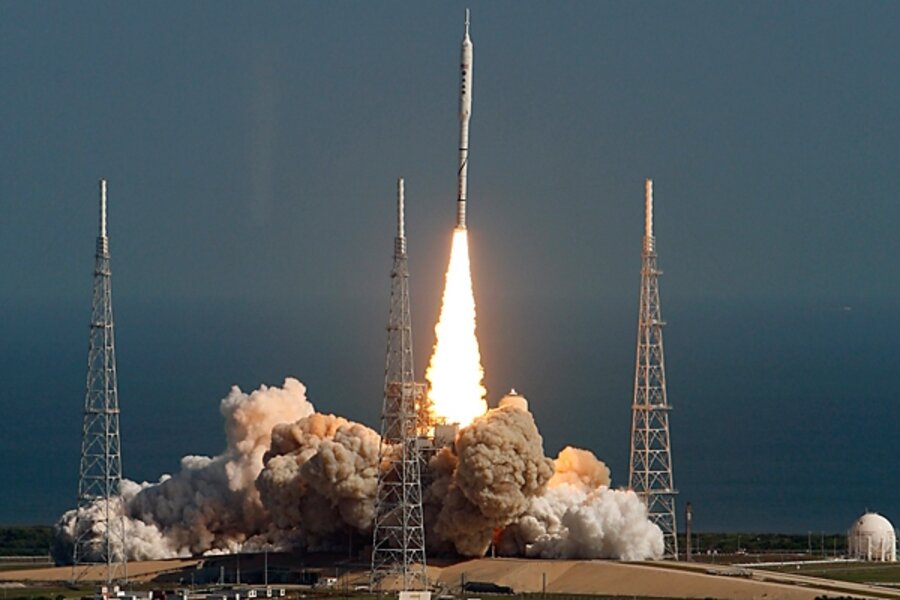NASA's Ares 1-X launch: 'How cool was this?'
NASA's Ares 1-X rocket vaulted into the history books Wednesday in a spectacular start to a human-spaceflight program facing an uncertain future.
The test flight met all the basic benchmarks for success, NASA officials say. And while they haven't had time to go through them yet, the engineering data the rocket's sensors delivered will be invaluable in getting the Ares 1 mission-ready.
"How cool was this?" said an ebullient Doug Cooke, NASA's associate administrator for the agency's Exploration Systems Mission Directorate, during a post-launch press briefing. The directorate oversees NASA's Constellation program. It's the follow-on to the space-shuttle program, which currently is scheduled to end in late 2010.
NASA spent two days trying to launch the 327-foot Ares 1-X, the experimental rocket that has a smaller motor than the Ares 1 and also a mock second stage. But the delays were weather-related, rather than the result of technical problems. When launch controllers got the break in weather conditions they were looking for, the rocket went off without a hitch.
While it will take time for Ares 1-X engineers to pore over the data, mission managers say they already have learned some useful things about the rocket.
Roll torque. For instance, designers anticipated far more twisting action as the rocket rose than it actually experienced. This "roll torque" results from slight variations in the way the solid fuel burns within the rocket motor, from the vehicle's shape, and from moving the nozzle at the motor's base in order to steer the rocket. Engineers had designed the roll-control system to handle 20 to 25 times the roll torque the vehicle actually experienced.
Triboelectrification. They also learned that they may not have to worry about the dreaded "T" word again: triboelectrification. It's the phenomenon that can occur as a rocket plows through water droplets or ice in high clouds. The collisions build up a charge of static electricity on the outside of the rocket. The build-up can interfere with radio transmissions between the rocket and controllers or damage sensitive electronics.
It's the main reason why the launch was delayed for nearly two days. The launch director was waiting for an opening in the high-level clouds that would last long enough to finish the countdown and launch the Ares 1-X.
One solution is to coat the rocket with materials designed to minimize the effect. The other is to show the rocket is designed in such a way that it doesn't need the coating. Ares 1-X engineers were in the process of gathering the information on the rocket's design that would exempt it from the triboelectrification flight restriction. But they didn't have time to finish their work before the test flight took place.
The next flight test, Ares 1-Y, isn't scheduled to take place until March 2014. That rocket will have the full five-segment rocket motor as a first stage. And it will test the Orion crew capsule's ability to escape from the rocket at high altitudes. If possible, planners would like to use an experimental motor in the second stage as well to see how it performs at high altitudes, according to Constellation program manager Jeffrey Hanley.
In the meantime, work is underway on other elements of the Ares 1/Orion system. For instance, the Orion capsule is slated for a test of its escape rocket early next year at the White Sands Proving Ground in New Mexico. Once the shuttle program ends, the money once spent on the shuttle will be channeled to the Constellation program.
The program faces an uncertain future, however, following the release of a report by a committee the Obama administration appointed to chart a financially sustainable course for the US human spaceflight program. The committee, led by former aerospace executive Norman Augustine, warned that without additional money, the Constellation program has little hope of doing more than building the Ares 1 but have no place to send it. (To read more about the report, click here.)
The White House is now weighing the options. Until it decides which course to pursue, however, NASA is under instructions to stay the course with its Constellation program.
-----
Follow us on Twitter.





